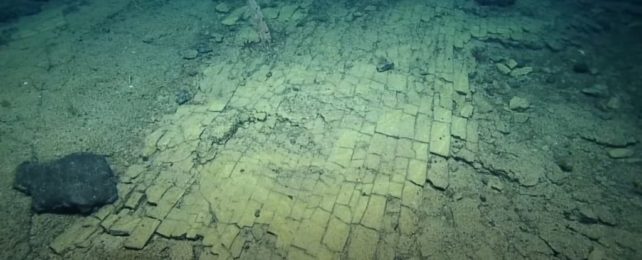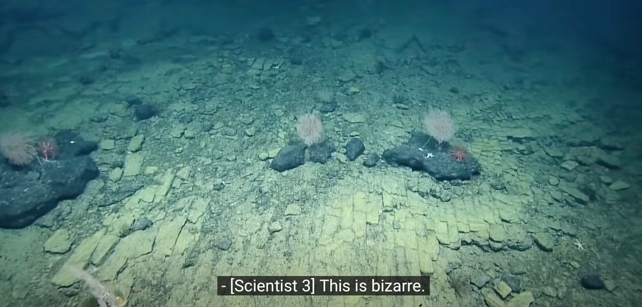
Having an ancient dried out lake bed 3000 meters underwater is a bit of a stretch. Do they really know this. More likely a volcanic remnant of some sort such as an ash event.
And the road may be a lava event.
It was still natural and hot to produce this cracking.
The Hawaiian Archipelago shows signs of a very slow motion subsidence along the track of the hot spot creating it.
Scientists Found a 'Yellow Brick Road' at The Bottom of The Pacific Ocean
04 November 2024
A deep-sea 'yellow brick road'. (The Ocean Exploration Trust/E/V/Nautilus/YouTube Screenshot)
An expedition to a deep-sea ridge, just north of the Hawaiian Islands, revealed a surprise discovery back in 2022: an ancient dried-out lake bed paved with what looks like a yellow brick road.
The eerie scene was chanced upon by the exploration vessel Nautilus, while surveying the Liliʻuokalani ridge within Papahānaumokuākea Marine National Monument (PMNM).
PMNM is one of the largest marine conservation areas in the world, larger than all the national parks in the United States combined, and we've only explored about 3 percent of its seafloor.
Researchers at the Ocean Exploration Trust are pushing the frontiers of this wilderness, which lies more than 3,000 meters below the waves, and the best part is, anyone can watch the exploration.
A highlight reel of the expedition's footage published on YouTube in April 2022 captured the moment researchers operating the deep-sea vehicle stumbled upon the road to Oz.
"It's the road to Atlantis," a researcher on the radio can be heard exclaiming.
"The yellow brick road?" another voice counters.
"This is bizarre," adds another member of the team.
"Are you kidding me? This is crazy."
Despite being located under about a thousand meters of ocean, the lake bed discovered by researchers on the summit of the Nootka seamount looks surprisingly dry.
On the radio, the team notes that the ground looks almost like "baked crust" that could be peeled off.
In one tiny section, the volcanic rock has fractured in a way that looks strikingly similar to bricks.

The researchers found the discovery to be very unusual. (The Ocean Exploration Trust/E/V/Nautilus/YouTube Screenshot)
"The unique 90-degree fractures are likely related to heating and cooling stress from multiple eruptions at this baked margin," reads a caption to the YouTube video.
At first glance, the effect is easily mistaken for a path to a wonderful new world. And in a way, that's not altogether wrong.
Following the brick road is a sign we're headed in the right direction and could soon learn a whole lot more about Earth's hidden geology.
You can read more about the 2022 E/V Nautilus expedition here.
An earlier version of this article was published in May 2022.
No comments:
Post a Comment